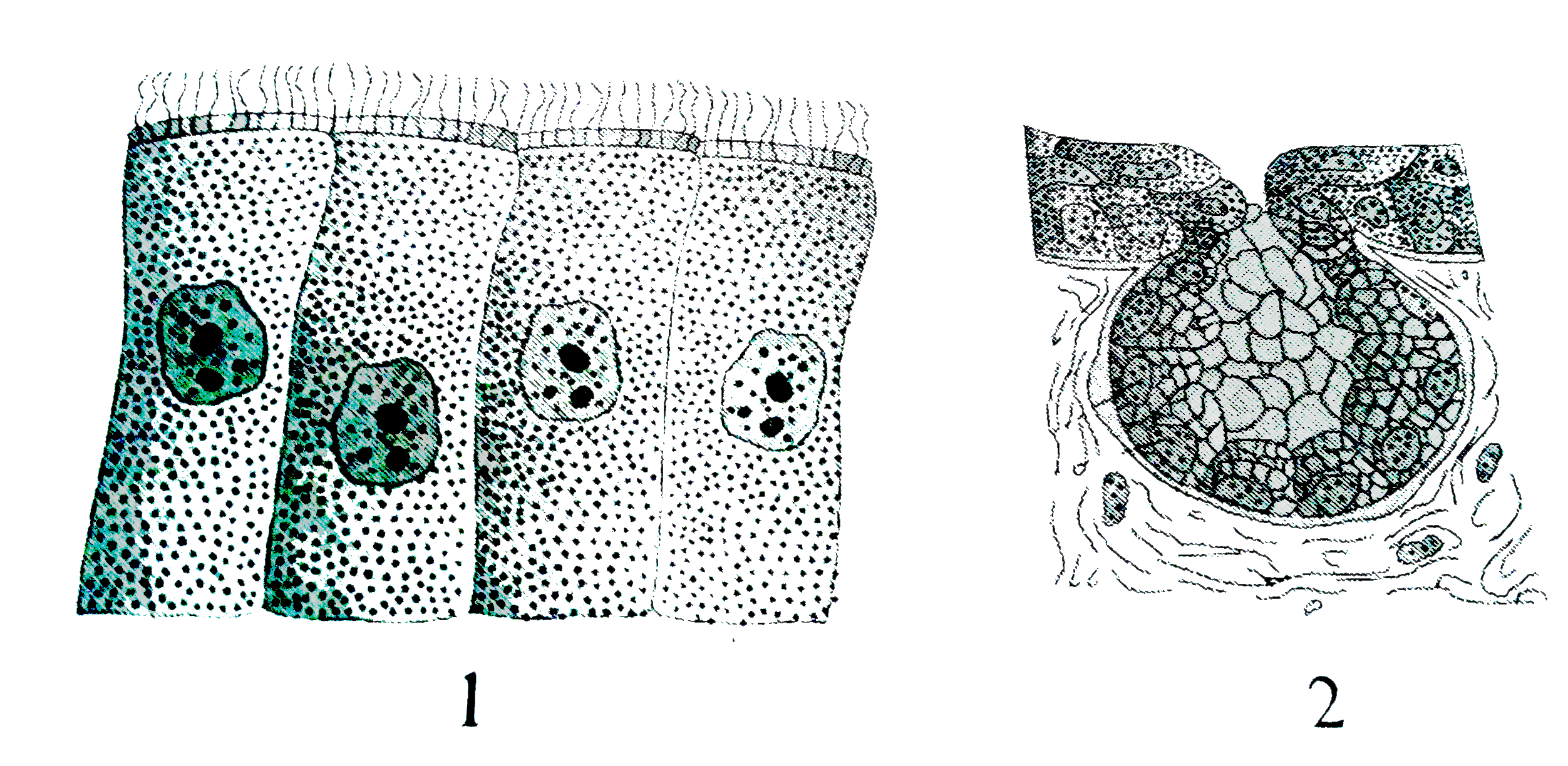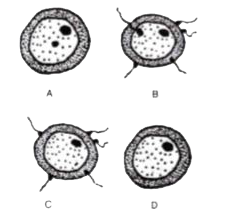A student is viewing under a microscope a permanent slide showing various stages of asexual reproduction by building in yeast. Draw diagrams of what he observes. (In proper sequence)
Step-by-Step Text Solution:
1. Identify the Parent Yeast Cell:
- Begin by drawing a single, round cell to represent the parent yeast. Label it as "Parent Yeast Cell". This cell contains one nucleus.
2. Budding Formation:
- Next, illustrate a small bulge or protrusion on the surface of the parent yeast cell. This bulge is the initial stage of budding. Label this as "Budding".
3. Nuclear Division:
- Show the nucleus within the parent yeast cell undergoing division. Draw two nuclei, one in the parent cell and one in the budding cell. This indicates that the genetic material is being replicated. Label this stage as "Nuclear Division".
4. Cytoplasmic Division:
- Illustrate the division of the cytoplasm. Draw the parent cell and the bud cell, indicating that the cytoplasm is being divided between them. Label this stage as "Cytoplasmic Division".
5. Formation of Daughter Yeast Cell:
- Draw the completed budding process where the bud has separated from the parent cell. Label this as "Daughter Yeast Cell". You can show multiple daughter cells if desired to indicate that this process can repeat.
6. Final Stage:
- Illustrate the daughter yeast cell growing into an adult yeast cell. Label this as "Adult Yeast Cell". This indicates that the daughter cell is now capable of undergoing the same asexual reproduction process.
- Begin by drawing a single, round cell to represent the parent yeast. Label it as "Parent Yeast Cell". This cell contains one nucleus.
- Next, illustrate a small bulge or protrusion on the surface of the parent yeast cell. This bulge is the initial stage of budding. Label this as "Budding".
- Show the nucleus within the parent yeast cell undergoing division. Draw two nuclei, one in the parent cell and one in the budding cell. This indicates that the genetic material is being replicated. Label this stage as "Nuclear Division".
- Illustrate the division of the cytoplasm. Draw the parent cell and the bud cell, indicating that the cytoplasm is being divided between them. Label this stage as "Cytoplasmic Division".
- Draw the completed budding process where the bud has separated from the parent cell. Label this as "Daughter Yeast Cell". You can show multiple daughter cells if desired to indicate that this process can repeat.
- Illustrate the daughter yeast cell growing into an adult yeast cell. Label this as "Adult Yeast Cell". This indicates that the daughter cell is now capable of undergoing the same asexual reproduction process.
Similar Questions
Knowledge Check
Below is the beginning excerpt from Meditations on First Philosophy, by Rene Descartes, 1641, in which he muses about the nature of knowledge. MEDITATION I. of the Things of Which We May Now Doubt 1. SEVERAL years have now elapsed since I first became aware that I had accepted, even from my youth, many false opinions for true, and that consequently what I afterward based on such principles was highly doubtful, and from that time I was convinced of the necessity of undertaking once in my life to rid myself of all the opinions had adopted, and of commencing anew the work of building from the foundation, if l desired to establish a firm and abiding superstructure in the sciences. But as this enterprise appeared to me to be one of great magnitude, I waited until I had attained an age so mature as to leave me no hope that at any stage of life more advanced I should be better able to execute my design. On this account, I have delayed so long that I should henceforth consider I was doing wrong were I still to consume in deliberation any of the time that now remains for action. Today, then, since I have opportunely freed my mind from all cares [and am happily disturbed by no passions), and since I am in the secure possession of leisure in a peaceable retirement, I will at length apply myself earnestly and freely to the general overthrow of all my former opinions. 2. But, to this end, it will not be necessary for me to show that the whole of these are false-a point, perhaps, which I shall never reach, but as even now my reason convinces me that I ought not the less carefully to withhold belief from what is not entirely certain and indubitable, than from what is manifestly false, it will be sufficient to justify the rejection of the whole if I shall find in each some ground for doubt. Nor for this purpose will it be necessary even to deal with each belief individually, which would be truly an endless labor, but, as the removal from below of the foundation necessarily involves the downfall of the whole edifice, I will at once approach the criticism of the principles on which all my former beliefs rested. 3. All that I have, up to this moment, accepted as possessed of the highest truth and certainty, I received either from or through the senses. I observed, however, that these sometimes misled us, and it is the part of prudence not to place absolute confidence in that by which we have even once been deceived. 4. But it may be said, perhaps, that, although the senses occasionally mislead us respecting minute objects, and such as are so far removed from us as to be beyond the reach of close observation, there are yet many other of their informations (presentations), of the truth of which it is manifestly impossible to doubt, as for example, that I am in this place, seated by the fire, clothed in a winter dressing gown, that I hold in My hands this piece of paper, with other intimations of the same nature. But how could I deny that I possess these hands and this body, and withal escape being classed with persons in a state of insanity, whose brains are so disordered and clouded by dark bilious vapors as to cause them pertinaciously to assert that they are monarchs when they are in the greatest poverty, or clothed lin gold) and purple when destitute of any covering: or that their head is made of clay, their body of glass, or that they are gourds? I should certainly be not less insane than they, were I to regulate my procedure according to examples so extravagant.
as used in line 10, the word "advanced" most closely meansAincreasingly complexBfar along in time.Cwith great skillDsignificantly improved.
A student is observing the temporary mount of a leaf peel under a microscope. Draw labelled diagram of the structure (of stomata) as seen under the microscope.
View SolutionA student was given a sample of two tissues. He observes the tissues under the microscope and draws their figures (1 and 2) as shown below .

Identify the tissues (1 and 2)
View SolutionA student measures the thickness of a human hair using a microscope of magnification 100. He makes 20 observations and find that the average thickness (as viewed in the microscope) is 3.5 mm. What is the estimate of the thickness of hair?
View SolutionGiven below are diagrams showing the different stages in the process of fertilisation of an egg in the human female reproductive tract.
Study the diagrams and answer the questions

(i) Arrange the letters given below each diagram in a logical sequence to show the correct order in the process of fertilisation.
(ii) Where does fertilisation normally take place? What is 'Implantation' that follows fertilisation ?
(iii) Mention the chromosome number of the egg and zygote in humans.
(iv) Explain the term 'Gestation'. How long does Gestation last in humans ?
(v) Draw a neat, labelled diagram of a mature human sperm.
View SolutionA student wants to project the image of a candle flame on a screen 60cm in front of a mirror by keeping the flame at a distance of 15 cm from its pole.
(i) Write the type of mirror he should use.
(ii) Find the liner magnification of the image produced.
(iii) What is the distance between the object and its image ?
(iv) Draw a ray diagram to show the image formation in this case.
View SolutionA student focussed the flame of a candle on a screen with the help of a convex lens. He noted the positions of candle, lens and screen on the scale as given below:
Position of candle = 14.0 cm, Position of convex lens = 50.0 cm, Position of screen = 86.0 cm
(i) Find the focal length of the lens.
(ii) If under the given condition, height of the flame is 1.5 cm, what would be the height of image obtained on the screen?
(iii) If he displaces the candle to 32.0 cm, where will the image be formed and what will be its nature? Give reason for your answer.
(iv) After this if he further displaces the candle towards the lens, what will be the nature of the image formed and where will it be?
(v) Draw a ray diagram to show the formation of image in the above mentioned case.
[Hints. (i) u = (50-14) cm = 36 cm, v = (86 - 50) cm = 36 cm.
Thus the object is at 2f. Therefore f = 18cm
(ii) Height will be same, i.e., 1.5 cm
(iii) u = 50-32 = 18 cm. Thus, object will be at focus. Therefore, image will be at infinity and is real, inverted and enlarged.
(iv) Object will come in between focus and optical centre.
Image will be virtual, erect and enlarged and formed on the same side of lens as the object.
View SolutionTarun observed a slide of white blood cells under microscope. His teacher asked him to draw the diagram. Select the diagram which should be drawn by Tarun.
View Solution
